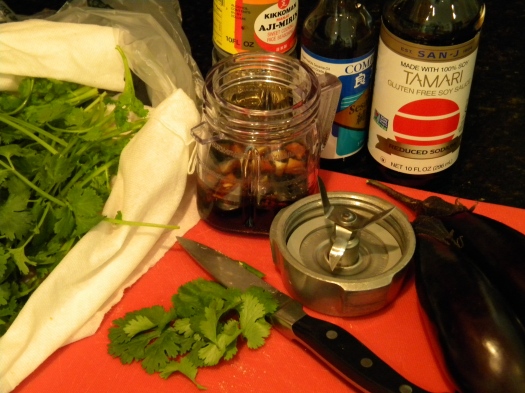
There is much talk these days about “slow food”, but this is about “slow posts”. I have been trying for over a week to get this posted. I didn’t have trouble getting to the Farmers’ Market to shop, that’s part of my Sunday routine. I bought the shiitake mushrooms, asparagus, scallions, and more green garlic so I could try a recipe I had found for Ginger Fried Rice. I made the recipe. It was delicious. I even got photos taken but what didn’t happen was finding the time to write and put the words and photos together. I’m sometimes amazed how long it takes. Do you have weeks where it seems like you go from Monday to Friday in just one day instead of five?
Shiitake mushrooms are, in my opinion, simply the best. I love the flavor and the texture finding them even meatier than a Portabella. I guess the edge the Portabella has is its size. I’ve never seen a Shiitake that comes even close to the Portabella in size and I’ve never tasted a Portabella that comes close in flavor to the Shiitake.

Also known, as Chinese black mushroom and black forest mushroom, shiitake are the second most cultivated mushroom in the world. They also have an ancient history being recorded in Japan back to AD 199 and in China there are written records of them during the Sung Dynasty (AD 960-1127). During the Ming Dynasty (AD 1368-1644), they were prized not only as a food but also as a remedy for upper respiratory diseases, poor blood circulation, liver trouble, exhaustion and weakness, and to boost life energy and prevent premature aging. Today they are still touted for their curative properties and extracts from the mushroom and sometimes the whole dried mushroom, are used in herbal remedies.
Prior to 1972 it was thought by the USDA that the species was invasive so cultivation was not allowed in the United States. In 1982, Gary F. Leatham published an academic paper based on his research on the budding and growth of the Japan Islands variety; the work helped make commercial cultivation possible in United States.
Today, mushrooms have become popular in many other countries as well. Russia produces and also consumes large amounts of them, mostly sold pickled, something I have never tried. There is a global industry in production, with local farms in most western countries in addition to large-scale importation from China, Japan, Korea and elsewhere. A lot of the imported mushrooms come to us dried. They have a very rich flavor but I prefer the texture of the fresh ones.
The fried rice recipe I made was a variation on one I found on epicurious.com.
Ginger Fried Rice with Shiittake Mushrooms and Asparagus
Makes 6 side-dish servings
2 tablespoons plus 1-teaspoon vegetable oil
2 large eggs, beaten with 2-tablespoons water
1 ½ tablespoons minced peeled fresh ginger (I recently read that you can freeze ginger root and just grate it into a recipe and that’s what I did this time and it works great. You don’t even need to fool around with peeling it)
3 scallions, white and green parts chopped separately
3 green garlic, white part and tender light green parts sliced thinly (optional)
½ lb asparagus cut on the diagonal into 1” pieces
¾ teaspoons kosher salt
½ lb fresh shiitake mushrooms, stems discarded and caps thinly sliced (you could substitute dried shiitake that have been soaked and drained, or you could try crimini but the flavor and texture of either of these will be very different than the shiitake. I definitely wouldn’t recommend using the white mushrooms.)
3 cups cold cooked white rice (I use a short grain white which tends to stick together more than the long grain but it worked just fine.)
½ teaspoon Asian sesame oil
Toasted sesame seeds (not sure how many I added probably a tablespoon or two)
Heat a wok or a 12-inch nonstick skillet over moderate heat until hot. Then add ½ teaspoon vegetable oil and swirl around wok/pan. Add half of egg mixture and swirl pan to coat bottom with a thin layer about 5 inches in diameter. When egg crêpe is set, about 45 seconds, transfer with a wide metal spatula to a plate to cool. Make another egg crêpe with remaining egg mixture. Roll each crêpe into a cylinder, and cut crosswise into ¼ inch-wide strips, then unroll. (This was so simple to do and I loved the way it looked and tasted. If you don’t want to make the crêpes, scramble the egg and water mixture)
Heat remaining 2 tablespoons vegetable oil in wok over high heat until it begins to smoke. Add ginger, white part of scallions, garlic and salt and stir-fry until fragrant, about 30 seconds. Add shiitakes and s and stir-fry until tender, 3 to 5 minutes. Crumble rice into wok add asparagus pieces and stir –fry until rice is lightly browned and asparagus is still crisp tender, 10 to 15 minutes. Remove from heat and add scallion greens, egg strips, and sesame oil, tossing to combine.
I don’t see why you couldn’t substitute broccoli for the asparagus. Just keep the pieces cut into sizes that will cook uniformly, or steam the broccoli separately then add at the end with the scallion greens and egg strips. I think I would also like to try this with bok choy as the vegetable. This is an easy meal to prepare, as with most stir-fries the longest time will be spent in preparation.
If you give this one a try let me know how you liked it and what substitutions you made.
38.580461
-121.530234
Share or print this post:






